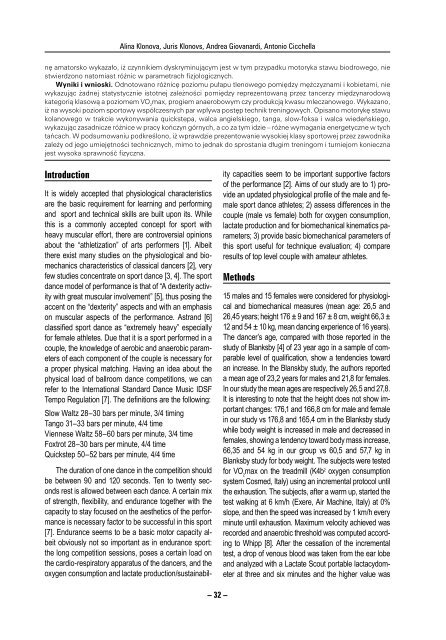Antropomotoryka nr 55.indb - Akademia Wychowania Fizycznego w ...
Antropomotoryka nr 55.indb - Akademia Wychowania Fizycznego w ...
Antropomotoryka nr 55.indb - Akademia Wychowania Fizycznego w ...
You also want an ePaper? Increase the reach of your titles
YUMPU automatically turns print PDFs into web optimized ePapers that Google loves.
Alina Klonova, Juris Klonovs, Andrea Giovanardi, Antonio Cicchella<br />
nę amatorsko wykazało, iż czynnikiem dyskryminującym jest w tym przypadku motoryka stawu biodrowego, nie<br />
stwierdzono natomiast różnic w parametrach fizjologicznych.<br />
Wyniki i wnioski. Odnotowano różnicę poziomu pułapu tlenowego pomiędzy mężczyznami i kobietami, nie<br />
wykazując żadnej statystycznie istotnej zależności pomiędzy reprezentowaną przez tancerzy międzynarodową<br />
kategorią klasową a poziomem VO 2<br />
max, progiem anaerobowym czy produkcją kwasu mleczanowego. Wykazano,<br />
iż na wysoki poziom sportowy współczesnych par wpływa postęp technik treningowych. Opisano motorykę stawu<br />
kolanowego w trakcie wykonywania quickstepa, walca angielskiego, tanga, slow-foksa i walca wiedeńskiego,<br />
wykazując zasadnicze różnice w pracy kończyn górnych, a co za tym idzie – różne wymagania energetyczne w tych<br />
tańcach. W podsumowaniu podkreślono, iż wprawdzie prezentowanie wysokiej klasy sportowej przez zawodnika<br />
zależy od jego umiejętności technicznych, mimo to jednak do sprostania długim treningom i turniejom konieczna<br />
jest wysoka sprawność fizyczna.<br />
Introduction<br />
It is widely accepted that physiological characteristics<br />
are the basic requirement for learning and performing<br />
and sport and technical skills are built upon its. While<br />
this is a commonly accepted concept for sport with<br />
heavy muscular effort, there are controversial opinions<br />
about the “athletization” of arts performers [1]. Albeit<br />
there exist many studies on the physiological and biomechanics<br />
characteristics of classical dancers [2], very<br />
few studies concentrate on sport dance [3, 4]. The sport<br />
dance model of performance is that of “A dexterity activity<br />
with great muscular involvement” [5], thus posing the<br />
accent on the “dexterity” aspects and with an emphasis<br />
on muscular aspects of the performance. Astrand [6]<br />
classified sport dance as “extremely heavy” especially<br />
for female athletes. Due that it is a sport performed in a<br />
couple, the knowledge of aerobic and anaerobic parameters<br />
of each component of the couple is necessary for<br />
a proper physical matching. Having an idea about the<br />
physical load of ballroom dance competitions, we can<br />
refer to the International Standard Dance Music IDSF<br />
Tempo Regulation [7]. The definitions are the following:<br />
Slow Waltz 28–30 bars per minute, 3/4 timing<br />
Tango 31–33 bars per minute, 4/4 time<br />
Viennese Waltz 58–60 bars per minute, 3/4 time<br />
Foxtrot 28–30 bars per minute, 4/4 time<br />
Quickstep 50–52 bars per minute, 4/4 time<br />
The duration of one dance in the competition should<br />
be between 90 and 120 seconds. Ten to twenty seconds<br />
rest is allowed between each dance. A certain mix<br />
of strength, flexibility, and endurance together with the<br />
capacity to stay focused on the aesthetics of the performance<br />
is necessary factor to be successful in this sport<br />
[7]. Endurance seems to be a basic motor capacity albeit<br />
obviously not so important as in endurance sport:<br />
the long competition sessions, poses a certain load on<br />
the cardio-respiratory apparatus of the dancers, and the<br />
oxygen consumption and lactate production/sustainability<br />
capacities seem to be important supportive factors<br />
of the performance [2]. Aims of our study are to 1) provide<br />
an updated physiological profile of the male and female<br />
sport dance athletes; 2) assess differences in the<br />
couple (male vs female) both for oxygen consumption,<br />
lactate production and for biomechanical kinematics parameters;<br />
3) provide basic biomechanical parameters of<br />
this sport useful for technique evaluation; 4) compare<br />
results of top level couple with amateur athletes.<br />
Methods<br />
15 males and 15 females were considered for physiological<br />
and biomechanical measures (mean age: 26,5 and<br />
26,45 years; height 176 ± 9 and 167 ± 8 cm, weight 66,3 ±<br />
12 and 54 ± 10 kg, mean dancing experience of 16 years).<br />
The dancer’s age, compared with those reported in the<br />
study of Blanksby [4] of 23 year ago in a sample of comparable<br />
level of qualification, show a tendencies toward<br />
an increase. In the Blanskby study, the authors reported<br />
a mean age of 23,2 years for males and 21,8 for females.<br />
In our study the mean ages are respectively 26,5 and 27,8.<br />
It is interesting to note that the height does not show important<br />
changes: 176,1 and 166,8 cm for male and female<br />
in our study vs 176,8 and 165,4 cm in the Blanksby study<br />
while body weight is increased in male and decreased in<br />
females, showing a tendency toward body mass increase,<br />
66,35 and 54 kg in our group vs 60,5 and 57,7 kg in<br />
Blanksby study for body weight. The subjects were tested<br />
for VO 2<br />
max on the treadmill (K4b 2 oxygen consumption<br />
system Cosmed, Italy) using an incremental protocol until<br />
the exhaustion. The subjects, after a warm up, started the<br />
test walking at 6 km/h (Exere, Air Machine, Italy) at 0%<br />
slope, and then the speed was increased by 1 km/h every<br />
minute until exhaustion. Maximum velocity achieved was<br />
recorded and anaerobic threshold was computed according<br />
to Whipp [8]. After the cessation of the incremental<br />
test, a drop of venous blood was taken from the ear lobe<br />
and analyzed with a Lactate Scout portable lactacydometer<br />
at three and six minutes and the higher value was<br />
– 32 –





![Antropomotoryka nr 57 [2012]. - Akademia Wychowania Fizycznego ...](https://img.yumpu.com/50213388/1/182x260/antropomotoryka-nr-57-2012-akademia-wychowania-fizycznego-.jpg?quality=85)











